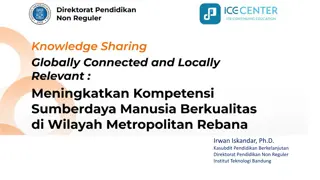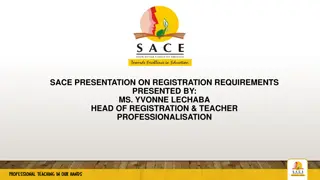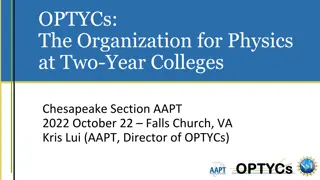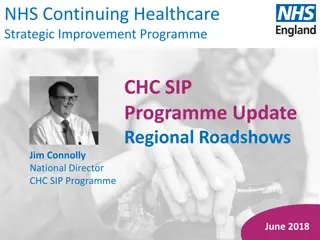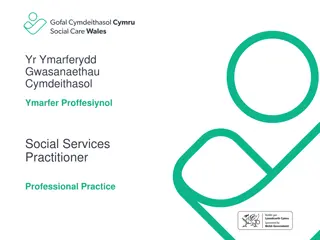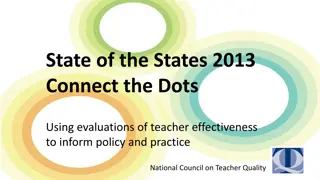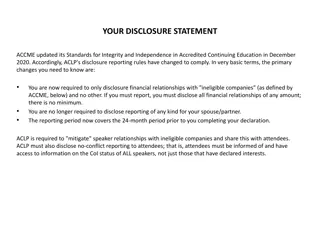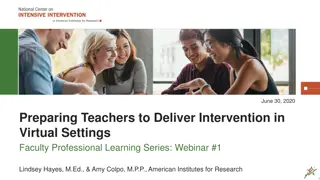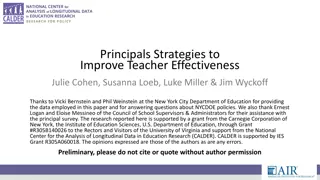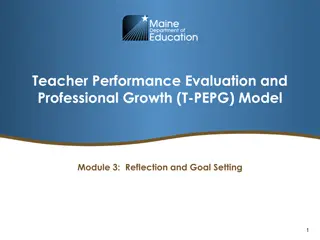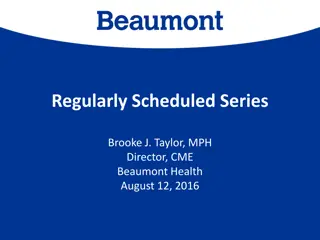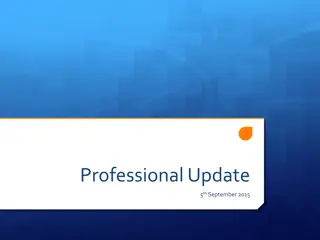
Professional Development and Teacher Education Insights
Explore insights on continuing professional development and teacher education, including discussions on professional teaching standards, challenges, recommendations, and the role of teacher leadership. Dive into the background and legislative context of the Ministerial Committee on Teacher Education in SA, along with an action plan towards Schooling 2030 to enhance teacher capacity and professionalism.
Download Presentation

Please find below an Image/Link to download the presentation.
The content on the website is provided AS IS for your information and personal use only. It may not be sold, licensed, or shared on other websites without obtaining consent from the author. If you encounter any issues during the download, it is possible that the publisher has removed the file from their server.
You are allowed to download the files provided on this website for personal or commercial use, subject to the condition that they are used lawfully. All files are the property of their respective owners.
The content on the website is provided AS IS for your information and personal use only. It may not be sold, licensed, or shared on other websites without obtaining consent from the author.
E N D
Presentation Transcript
CONTINUING PROFESSIONAL DEVELOPMENT Chairperson: Ms Faseega Solomon Presenters: Mr E. Rabotapi / Mr B. Mchunu Scribe/Rapporteur: Mr B. Mnisi Resource Persons: Ms Thembi Majikijela Ms Vonani Mathonsi / Ms Gugu Makhoba / 2 Professional Teaching Standards - DRAFT FOR CONSULTATION WITH TEACHERS & SUBJECT AND PHASE SPECIALISTS
Questions to Guide the Discussions and Engagements 1. How are teachers experiencing different types of continuing professional development opportunities and the CPTD system? 2. In what ways is participation in professional development and the CPTD system enabled and/ or constrained by teacher leadership, agency, autonomy and voice? 3. How can Professional Learning Communities be promoted to enhance collaborative and collegial continuing professional development and learning by teachers for teachers? 4. What challenges are experienced in participation in professional development and the CPTD system? How can teachers use their voice, leadership and agency to address these challenges? 5. What are the five key recommendations from the Continuing Professional Development parallel session to plenary? 3 Professional Teaching Standards - DRAFT FOR CONSULTATION WITH TEACHERS & SUBJECT AND PHASE SPECIALISTS
(Background & Legislative Context) MINISTERIAL COMMITTEE ON TEACHER EDUCATION IN SA (2003-2004) 1. Develop a National Framework for Teacher Education in SA; 2. to chart a long-term vision of a co-ordinated and coherent system of initial and continuing professional education of teachers 3. To focus on the systemic role that teacher education has in the overall transformation of education.
Background & Legislative Context MINISTERIAL COMMITTEE ON TEACHER EDUCATION IN SA (2003-2004) Recommendations Recommendation C16 Support the development of a CPTD system by encouraging, resourcing and empowering the SACE to manage such a system. Recommendation C17 Authorized the SACE to fulfil its mandate for the professional development of educators by establishing a CPTD system, which will endorse professional development activities and allocate Professional Development Points to them, keep a register of endorsed PD activities and maintain a record of PD Points earned by Registered Educators.
ACTION PLAN TO 2019 TOWARDS SCHOOLING 2030 Goal 16: Teacher capacity and professionalism Improve the professionalism, teaching skills, subject knowledge and computer literacy of teachers throughout their entire careers. 6
TEACHER DEVELOPMENT SUMMIT:2009 WHAT THE SUMMIT SOUGHT TO ADDRESS: Poor capacity of the system to respond to TD needs; Poor quality of TD programmes Delivery of TD programmes that was uncoordinated, without proper institutional mechanisms; Programmes that were not needs based and without impact in the classroom; Unstructured funding mechanisms Poor systems for needs identification 7
OVERVIEW Integrated Strategic Planning Framework for Teacher Education and Development OUTPUT 1 OUTPUT 2 OUTPUT 4 OUTPUT 3 Individual and systemic TD needs are identified and addressed Increased numbers of high achievers are attracted into teaching An expanded and accessible formal teacher education system is established Teacher support is enhanced at a local level ENABLERS Time Collaboration Coordination Funding 8
7.1. How are teachers experiencing different types of continuing professional development opportunities and the CPTD system? Challenge /Problem Teachers have been exposed to a lot of training programs and workshops. These have proved to have little effect since not all teachers are able to put into practice what they have learned; Recommendation Coordination at different levels Professional Capital Social Capital ( Network and collaboration) PLCs and professional associations) Many teachers are not taking personal responsibility for their own development and are depending on workshops by the system. A mind-set shift is required. Decisional Capital ( autonomy and agency)
7.1. How are teachers experiencing different types of continuing professional development opportunities and the CPTD system? Challenge /Problem The system of Teacher Professional Development has largely been manual and paper-based; Structures and programs for Teacher Development have not been sufficiently coordinated and funded, and The notion of teacher accountability within the system has been weak. Recommendation Move from paper based to digital based TD system Ring fence the Skills Development Levy Professional Capital, Social Capital ( Network and collaboration) Decisional Capital ( autonomy)
7.1. How are teachers experiencing different types of continuing professional development opportunities and the CPTD system? Challenge Platforms for Delivery ( Institutes and Centres , Online , Time during schooling time) Recommendation Resourcing and funding
7.2. enabled and/ or constrained by teacher leadership, agency, autonomy and voice? In what ways is participation in professional development and the CPTD system Challenges Teacher Leadership Autonomy Agency Voice Mis- alignment ( needs identification) Structured way of teaching ( scripted way) Historical background (Leadership in schools) Gaps in ITE Mechanical (ticking boxes) Recommendation Policy determination Identifying what they need to develop professionally IQMS v/s QMS ( make schools centres for teacher development) Allow teachers autonomy Induction Training of principals
7.2. enabled and/ or constrained by teacher leadership, agency, autonomy and voice? In what ways is participation in professional development and the CPTD system Challenges CAPS Policy ( How it constrains autonomy and agency) Monitoring by subject advisors Recommendation CAPS & ATP ( allow for flexibility)
7.2. system enabled and/ or constrained by teacher leadership, agency, autonomy and voice? In what ways is participation in professional development and the CPTD Challenges CPTD user-friendliness, quality control, PLCs, ICT integration, Working in silos, PED CPTD official and SACE co-ordinators) Recommendation System Review and optimisation PLCs, (Strengthening PLC) ICT integration ( Digital skills for the changing world) overcoming silos, PED CPTD official and SACE co-ordinators) stronger institutionalization of the programme throughout the system Treasury, DBE, PEDs, Schools, HEIs, Unions, SETA etc)
7.3. collaborative and collegial continuing professional development and learning by teachers for teachers? ( Teacher Professionalisation) How can Professional Learning Communities be promoted to enhance Challenges Conceptualisation of the PLCs within the SA Context Recommendations Conceptualisation of the PLCs ( Guiding principles) Teacher driven Teacher agency ( Teacher own solutions)
7.4. development and the CPTD system? How can teachers use their voice, leadership and agency to address these challenges? What challenges are experienced in participation in professional Challenges Lack of understanding the NPFTED Policy Intentions and the CPTD system as a collaborative system Uneven Level of implementation across the 9 provinces Lost / Forgotten Username and Password Recommendation Collaboration with all role players Funding ( Leadership and agency) CPTD System Review
7.4. development and the CPTD system? How can teachers use their voice, leadership and agency to address these challenges? What challenges are experienced in participation in professional Challenges Lack of motivation to participate Recommendation Teacher professionalisation Educators that not linked to schools System Optimization Requirements: ( recommendations slide 20) Advocacy and Orientation General Reporting challenges on the CPTD IS Advocacy and Orientation (NQT) Orientation done between 2013 & 2014
7.4. development and the CPTD system? How can teachers use their voice, leadership and agency to address these challenges? What challenges are experienced in participation in professional Challenges The use of different registers for different stakeholders Type 3 activities not endorsed (PEDs) Recommendation Use one register PEDs to submit PD activities for endorsement( new and for expired)
7.4. development and the CPTD system? How can teachers use their voice, leadership and agency to address these challenges? What challenges are experienced in participation in professional Item Points schedule Discussion The PD points V/S the duration of the PD activity Recommendation System review ( Useability, functionality) The use of old concepts in the SACE CPTD-IS system ( ANA, IQMS, etc) The PD point weighting review
Some System optimisation recommendations 1.Simplify Login Process, 2.Strengthten Security requirements: - Current Username & Password are too generic and Predictable, - Migrate into a Mobile App Platform, in the Standard Online Banking features and security, 3.When you log in, the App should send a verification OTP, Similar to online Banking or Purchase to the registered Cell Phone number. 4.Lost password reset option should have an Email and OTP verification option for the user to choose the convenient at the time. Just like in Online Banking. 5.The App should keep an Audit Trail of all user activities and report any irregular use and abuse to the System Administrator and Line Manager.
OPPORTUNITIES Platforms for delivery Institutes and centers Online TD Platform Time during school holidays Grant for management of CPTD CPTD Management system in place SACE ELRC Processes Revisit ELRC CA 4 of 2003 to address Career Pathing Management of skills budget Skills Levies 21
7.5. What are the key recommendations from the Continuing Professional Development parallel session to plenary? Take back the Locus of Control to the Schools Create Time for PD Career Pathing Strengthen Initial Teacher Education Incentives Teachers ( Repositioning of SACE
7.5. What are the key recommendations from the Continuing Professional Development parallel session to plenary? Protect funding for CPTD Strengthen Partnerships Strengthen structures responsible for CPTD Working with Universities ( Teacher Union Institutes)



